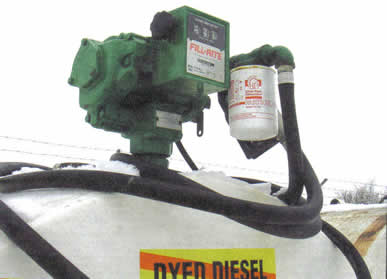
Defensive Diesel Fuel
Changes in emission standards are causing changes in diesel engine design which in turn makes proper fuel storage more critical than ever on your farm.
If you have a new tractor and it seems that the fuel filters are plugging more frequently than before, welcome to the changing world of tighter emission controls, more sophisticated fuel systems on your equipment, and the need for increasing scrutiny of your on-farm supply of diesel fuel.
Presentations at the Farm Smart Conference in Guelph this past January by Mark Bridgen of AgraTurf and Bob Peden of UPI outlined the changes that are occurring in the world of diesel engines and fuel systems and the things producers need to do in order keep engines running smoothly now and into the future. Bridgen pointed out that in an effort to meet emission control standards, fuel systems have had to change dramatically and that some of the biggest changes are still to come. Diesel engines of the past may have used fuel systems pressurized to around 2500 psi and used injectors that cost $70. Now, agricultural engines may have fuel systems that run at 30,000 psi for pressure and employ electronically controlled injectors that cost $500 to replace. On the filter side where a 20-30 micron filter used to be common, most new engines are coming with a secondary filter of 2 microns. (Human hairs measures in at about 100 microns in diameter). The take home message from the engines side of the story is that if your fuel supply is not clean, expect your filters to be plugging more frequently because of their tighter tolerances, and since no filter is 100% efficient, expect dirt or water that makes it past the filter to cause more expensive grief than it ever did in an older style engine.
 |
Installing filters on
all on-farm storage tanks, including transfer tanks in the back of pick-ups,
is critical in maintaining a clean fuel supply. |
The following checklist points out
the critical steps in keeping your on-farm diesel supply clean:
1. Be sure that all on farm storage tanks have filters installed after the pump.
10-15 microns is the recommended size. This is JOB ONE for transfer tanks in
the back of pick-up trucks as they are often the worst culprits when it comes
to dirty fuel making its way to engines.
2. Fuel tank draw tubes should be no closer than 4" (10 cm) from the bottom
of the tank.
3. Ensure that fuel tanks are tipped slightly away from the draw tube end of
the tank.
4. Fuel tanks should be dip tested (with water sensitive paste) to check for
the presence of water in the tank, and appropriately drained if water is found.
5. Allow diesel storage tanks to settle after filling before transferring fuel
to your farm equipment.
6. Keep all tanks (including fuel tanks on tractors, combines, etc.) full when
not in use to avoid condensation problems.
7. Carefully clean around fill caps before removing when filling fuel tanks
8. Be sure breathers on all fuel tanks are working properly.
2005 will be a year where profit margins won't allow for many of the upgrades or improvements that you could envision for your farm operation. However, a few hundred dollars and a half day's work installing fuel filters and checking storage tanks may eliminate costly repairs or critical downtime.